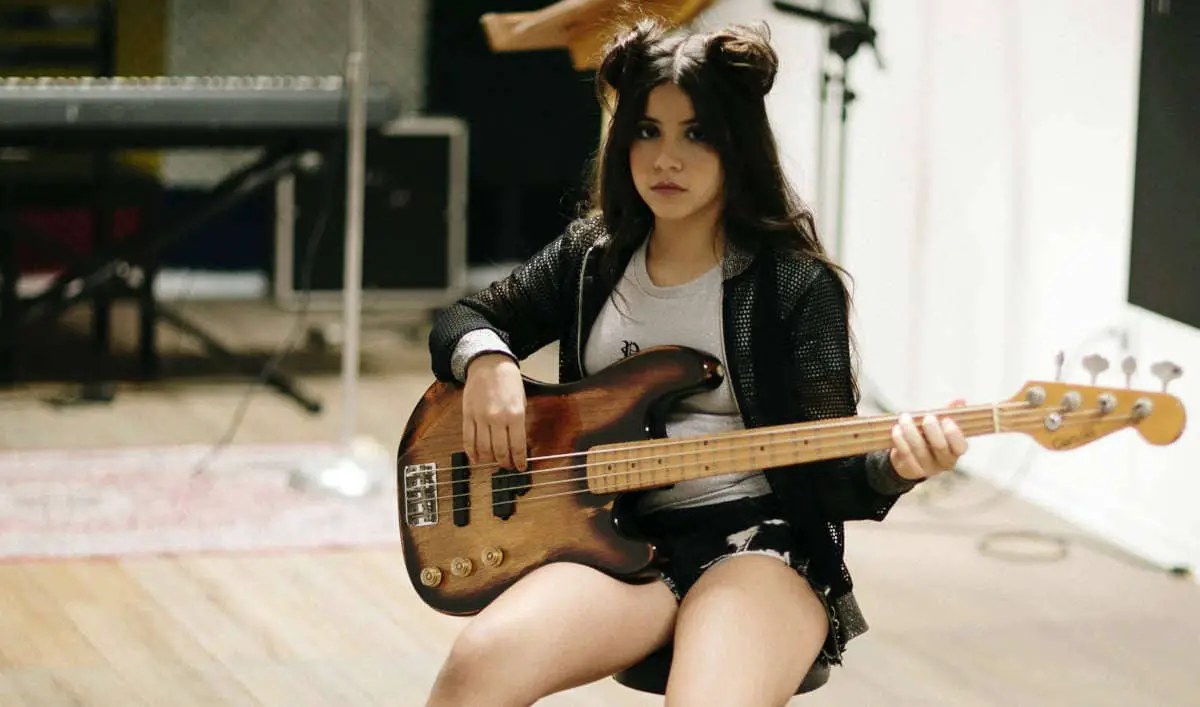When I got my first bass 16 years ago, I still lived with my parents and could not make too much noise. Thus, while I had an amplifier for my bass, I ended up using it far less than I would have liked to.
As a result, I often ended up playing my electric bass acoustically. While this was better than nothing, I regret it in hindsight, as I ended up developing bad habits in my playing as a result.
Therefore, I decided to write this guide for anyone who is looking to play bass guitar without an amplifier.
You will learn whether an amp is necessary to play the bass, and alternative ways to create an amplified sound with an amp. I will also explain how you can and cannot use headphones, and whether you need an amp when playing bass live.
Is an amp necessary to play the bass?
If you are playing at home, you can record or amplify your bass through your computer or phone without an amp. There is also the option of using a mini amp and headphones, which will produce an amplified bass sound only you can hear.
As for rehearsals and for playing your bass live, it is generally possible to amplify the bass through a PA system. This means that rather than being amplified through a bass amp, your bass is played through the public speaker system at the venue.
Thus, if you are asking yourself “Do I need a bass amp?”, consider what you are looking to do as a bassist and take a look at this table:
| Activity | Possible without an amp? | How is it possible? | Required equipment |
| Rehearse alone | Easily possible | Unamplified, or by using other equipment than an amplifier. | None / AmPhones / Microamp / Audio interface and instrument cable. |
| Rehearse with a band | Generally possible | Plugging bass directly into the PA system | DI box, Rehearsal space with a PA system |
| Play live with a band | Generally possible | Plugging bass directly into the PA system, or using equipment available at the avenue. | DI box, playing avenues with suitable PA systems and equipment, or a bass amp. |
| Record at home | Possible | Plugging your bass directly into an audio interface. | Audio interface, instrument cable, and DAW software. |
| Record in a studio | Easily Possible | Recording studios will have all the required equipment to record bass | None |
So to answer this question, no you don`t need an amplifier to play the bass.
However, playing it acousticly is both unideal for developing your technique and a lot less fun. Thus, let`s continue by looking at some ways to make your bass sound amplified without actually using an amp.
How to play bass without an amp
It is possible to play the bass without an amp as you can clearly hear and distinguish different notes when playing an unamplified bass. The sound can also be improved by playing in rooms with great acoustics such as a bath, or by changing to a set of strings.
How clearly your gonna hear your bass when playing unamplified depends a lot on your technique. Fingerstyle is the softest, and playing with a pick is significantly louder. Slapping and popping is the loudest technique of them all.
When I play the bass alone nowadays, I tend just to pick it up and jam on it acoustically. Naturally, I don’t get close to getting the power and tone an amp would give me, but it works great for writing, exploring ideas, jamming, and just some quick fun.
I don’t recommend only doing this though. The main thrill of playing bass lies in getting a thick sound and tweaking it to your style. Thus, if you are not gonna play with an amp, I recommend amplifing your bass in one of these ways:
1. Using a computer
By plugging your bass into an audio interface you can effectively use your desktop device as a speaker.
For this, I highly advise plugging in some headphones and using these as your output device, rather than your speakers.
There are countless DAWs (Digital Audio Workstations) and Bass amp plugins you can use to get just the type of sound you want for your bass when using this method.
2. Using a Mini Amp
While it is technically an amp, I consider Mini Amps to be more of a dongle between headphones and your bass.
Plug the Mini Amp into your bass and your headphones into the mini amp, and you will get an amplified bass sound. This is cheaper for you and less loud for your neighbors than using an amp.
3. Using your phone
While often less practical than using a computer, you can also amplify your bass with your phone.
This requires a dongle that works the same as an audio interface, such as the iRig.
This is a great option if you want to play or record while you are on the go and is a significantly cheaper solution than getting an audio interface for your desktop.
4. Resting the bass against objects
This method is cumbersome, and should in my opinion only be used as a last resort. However, it does work.
When you rest your bass against an object such as a table or a shelf, the vibrations will be transferred onto the object leading to a more “amplified” sound.
The least awkward way to go about this is to rest the head of the bass against a thick flat surface.
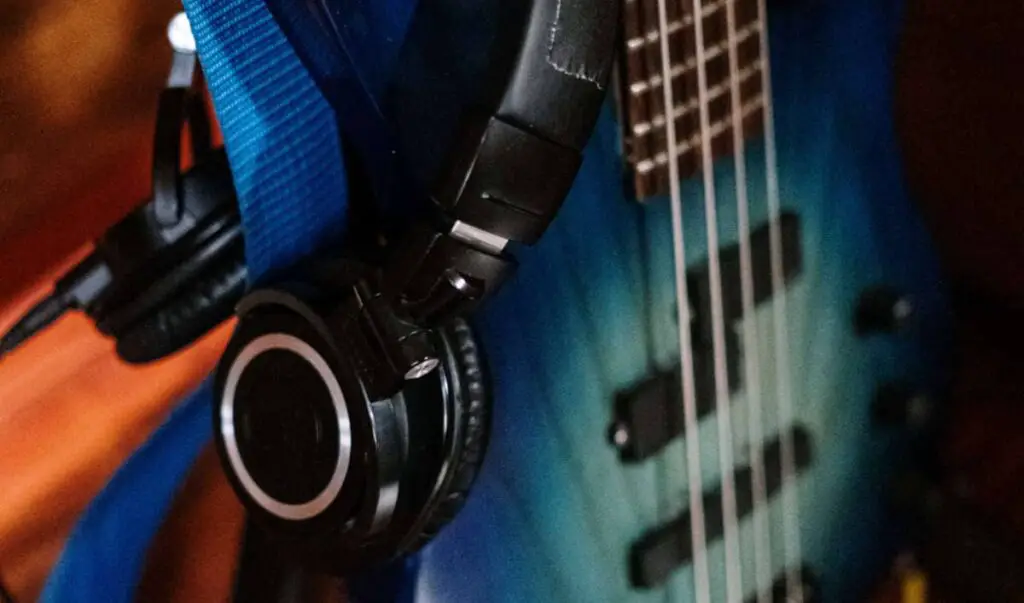
Can I plug headphones into Bass?
You cannot amplify your sound sufficiently by plugging your headphones directly into your bass. This is only possible with a set of headphones that have a built-in amplifier. For regular headphones, you will need to use a mini amp as a dongle between your bass guitar and headphones.
It is common for bassists to practice with headphones on. You just need the right equipment to make this happen.
One way to do this is to get a pair of headphones with a built-in amplifier. This is the simplest way to plug headphones into a bass, as there is no need for an extra dongle. Click here to see current prices for it on Amazon.
However, the cheapest way to plug your headphones into your bass is to get a bass to headphone adapter. I briefly touched on these earlier, and if you are mainly looking to play with headphones on, I recommend getting one.
Bass to headphone adapters are a lot more affordable than getting an amplifier, and you can use them with any headphones that have a cable. You can get one of Amazon here.
Another thing to consider is what headphones you are using. It is common for cheaper headphones and earphones to have poor bass. You don`t need $300 headphones, but you should get a decent pair that can handle the low frequencies of the bass.
If you don’t own a decent pair of headphones already, purchasing headphones with a built-in amplifier will generally prove cheaper than buying an adapter and new headphones.
Playing bass live without an amp
Playing bass live without an amp is a common practice. I and countless other bassists do it regularly, and some bassists never use amps live at all.
First, you will need to balance the signal your bass sends out using a DI box. Direct injection boxes, or DI boxes for short, convert unbalanced signals from the bass into balanced ones. The Radial Pro is a popular and affordable option, and you can get one off Amazon here.
This protects your signal from interference, which could stop your instrument from buzzing, and also allows for a longer instrument cable. The PA system that you will be plugging your bass into is also not designed to handle the raw signal of your bass the way a bass amp is. The DI box makes the signal that your bass sends to it compatible.
A PA System (Public Address system), receives, combines, and amplifies one or more audio sources. You are essentially plugging your bass directly into the soundman mixer, rather than into your own amp. Every venue intended for amplified live music should have a PA system.
I took a look into how many bass players use this method. While I`ve tried both and don`t really mind either, I was surprised to find that 83.4% of bassists prefer playing with an amplifier live.
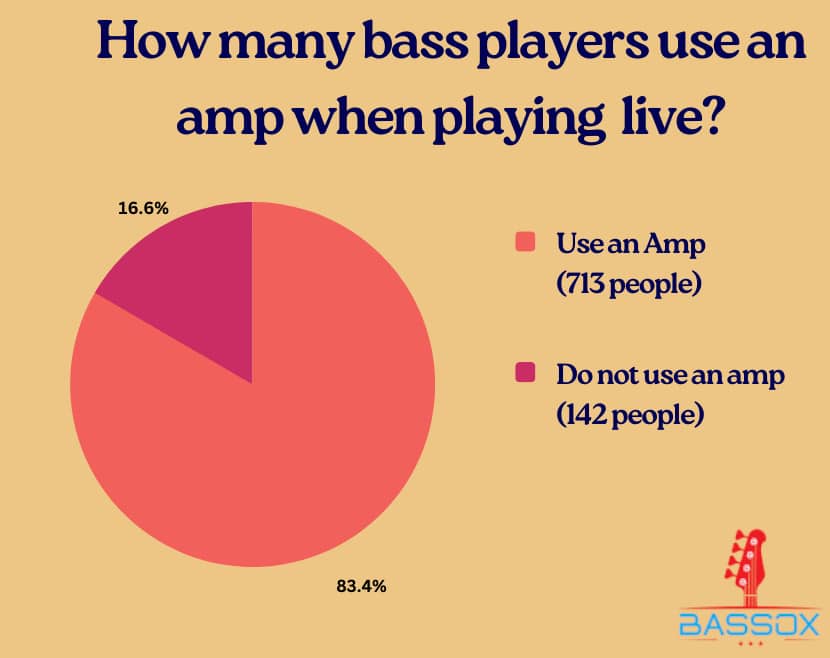
If you are in the early stages of being in a band, where you don’t have your own soundman, playing bass without an amp has its risks. You will be relying on the equipment of the concert venue and on for the soundman to know what he is doing.
Important note: When playing bass through a PA system, I and many other bassists have faced the issue of getting poor sound in our monitors. Having in-ear monitors thus makes it a lot easier to play live when playing without an amp.
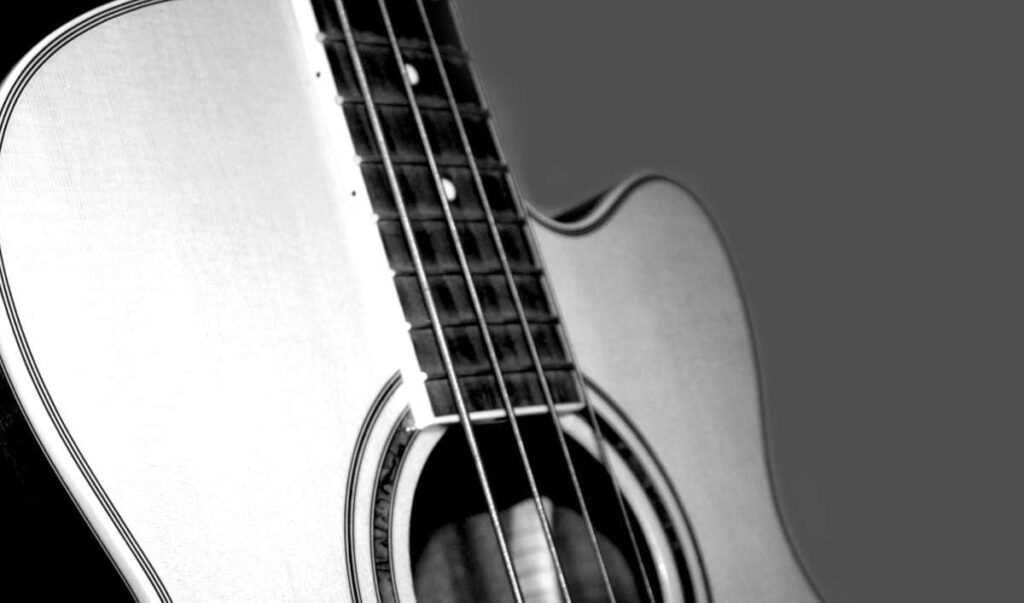
Can you play acoustic bass without an amp?
An acoustic bass can be played without an amp, but the volume is lower than that of an acoustic guitar. Unless you are playing in a tiny location, it will be difficult to properly hear the instrument. Therefore, it is common for acoustic basses to have pickups and for them to be amplified.
I, like many others, used to think of the acoustic bass as a similar instrument as the acoustic guitar. As many guitarists play an acoustic guitar without an amp, it would only make sense that the same is possible on an acoustic bass too, right?
Well, it is possible, but most acoustic basses will sound underwhelming and low in volume without an amp. Thus, while some higher-end acoustic basses can get somewhat louder, the instrument is generally a poor substitute for an amp.
The upside of an acoustic bass – The acoustic 4-string has a great and distinct sound. Bands such as Alice in Chains and Red Hot Chili Peppers have used it on several songs to create a unique aesthetic. Listen to the songs Road Trippin and Nutshell to get an idea of how the acoustic bass can make songs both intimate and powerful.
The downside of an acoustic bass – This instrument has a large body that makes it difficult to play, especially for fingerstyle players. If you are used to playing electric bass, it will take some time to get used to the shape of the acoustic 4-string. It is also common for bassists to feel uncomfortable when first trying it out.
Can you play bass on a guitar amp
It is possible to play bass on a guitar amp. Guitar amps are however not intended to handle the lower range of the bass. Thus, higher volumes and lower frequencies can damage the amp. In order to avoid damage it’s best to play at lower volumes and above the 7th fret on your A string.
Playing bass on a guitar amp works the same way as on a bass amp. You plug in your instrument cable into the amp and into your bass, adjust your sound, and rock out.
If you have an old guitar amp laying around or you can get your hands on one cheaply, this can work as a practice amp for your bass. Do not use a guitar amp that you can’t afford to damage or one that has sentimental value to you.
In general, your bass is going to produce a thinner sound on a guitar amp than on a bass amp. Thus, I mainly recommend using a guitar amp for solo practice.
The bass plays such an important role in the overall sound of a band that playing with a subpar tone in a rehearsal can have a negative impact on the band as a whole. Live gigs are even worse, as playing bass through a guitar amp can make both your sound and image appear amateurish.
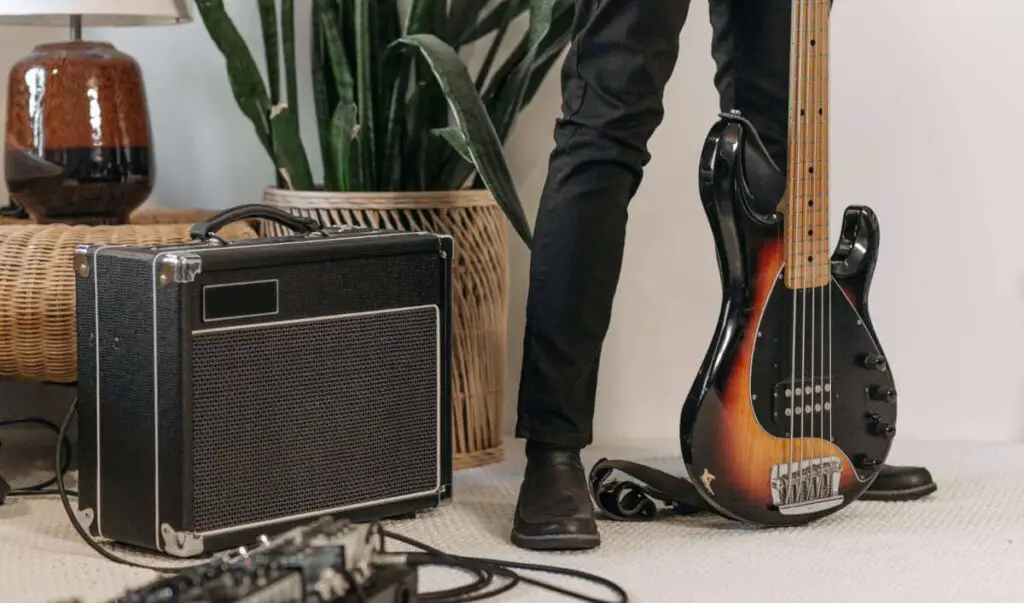
What kind of amp do I need for a bass?
For a full band rehearsal, a 60-100 watt bass amp will be sufficient, depending on your lineup and sound. For live performances, it is generally preferable to have at least a 300-watt amp; amps in the 100-150 watt range are viable for smaller venues.
Lastly, I wanted to briefly touch on what type of amp you will need if you do decide to get one.
I have used this Behringer 60-watt amp for solo practice for years, and it is more than sufficient. You can even use a headphone adapter with decent headphones and get a decent sound when playing alone.
If you are going to use an amp in your live performances I recommend at least a 300-watt amp. For most gigs, this will be more than sufficient, but you will need an amp that is loud enough for every type of gig that you play. Therefore, never go too small.
Keep in mind: You can generally plug your amp into the PA at concert venues. The times when a soundman might not let you do this will be at smaller venues. Hence, a 100-150 watt amp will often be enough for a venue of this kind.
As for band rehearsals, you need to take a look at what type of music you are playing. Are you in a jazz trio consisting of piano, bass, and drums? Or are you in a death-metal band with 2 guitarists tuned down to drop A?
For the Jazz trio, a 60-watt will easily do. For the death-metal band, you better hope that your poor 100-watt amp holds up.
Conclusion
An amplifier is not a necessity for learning, playing, or performing live with the bass.
Technically, it’s even possible to make a living off playing bass without even owning an amp.
If you are going to be a bassist and not own an amp, the most important part is to be aware of your limitations. Thus, if this article made playing bass without an amp sound like a massive hassle, I would recommend buying an amp. If it inspired you to try it, and your rehearsal space allows for it, I say go for it.
Even if playing bass without an amp ends up not working out for you, you can always just get an amp later on. The perspective of surviving as a bassist without an amp is a valuable learning experience. Notably, you will learn a lot about the bass as an instrument, live sound, and what gear a band needs as a whole to function.

